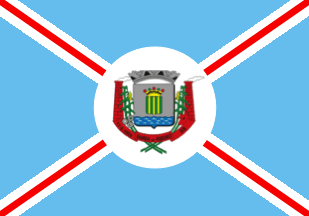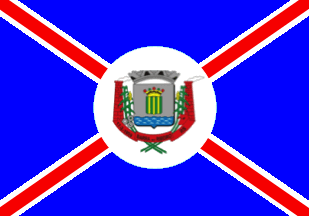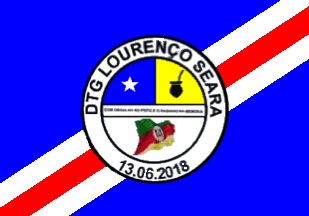 image by Ivan Sache,
12
July 2020
image by Ivan Sache,
12
July 2020
Last modified: 2020-07-13 by ian macdonald
Keywords: rio grande do sul | barra do ribeiro |
Links: FOTW homepage |
search |
disclaimer and copyright |
write us |
mirrors
 image by Ivan Sache,
12
July 2020
image by Ivan Sache,
12
July 2020
The municipality of Barra do Ribeiro (13,316 inhabitants in 2016; 73,082 ha)
is located 60 km south of Porto Alegre.
Barra do Ribeiro was settled in
1800, as Charqueada. This name recalls a ranch ("charqueada", producing salted
beef meat, "charque") established by Antônio Alves Guimarães on a domain granted
in 1780 by Luis Vasconcelo e Souza. The settlement was renamed for the
confluence ("barra") of stream Ribeiro with river Guaíba. Originally part of
Porto Alegre, Barra do Ribeiro was elevated to a district of the municipality of
Triunfo, established in 1831. A project of re-incorporation of Barra, Dores and
São João to Porto Alegre, tabled in 1837 at the Provincial Assembly, failed.
They were, however, re-incorporated to the state capital by Law No. 14
promulgated on 15 April 1846.
Barro de Ribeiro was transferred in 1857 to the
newly established municipality of Dores, which was suppressed in 1861, though.
In 1872, the parishes of Belém, Pedras Brancas and Barra formed Porto Alegre's
3rd district. Barra was elevated in 1896 to the seat of Porto Alegre's 7th
district, subsequently of the 8th district (1915) and of the 10th district
(1926).
In 1926, Barra do Ribeiro was transferred to the newly established
municipality of Guaíba, as its 2nd district, and granted the rank of "vila" in
1938.
The municipality of Barra do Ribeiro was established by State Law No.
3,719 promulgated on 17 February 1959, and inaugurated on 17 June 1959.
https://www.barradoribeiro.rs.leg.br/
Municipal Chamber website
Ivan Sache, 12 July 2020
The flag and arms of Barra do Ribeiro, designed by the
heraldist Arcinoe Antonio Peixoto de Faria, are prescribed by Municipal Law No.
287 promulgated on 4 January 1974.
On the flag, the coat of arms
represents the municipal government while the white circle represents the town
proper - seat of the municipality. The white color symbolizes peace, friendship,
work, prosperity, purity and religious feeling, while the circle is a symbol of
eternity, as a geometric figure without either beginning or end. The white
stripes superimposed with red stripes quartering the flag represent the spread
of the municipal power all over its territory. The red color is a symbol of
patriotic love, dedication, audacity, intrepidity, courage and valiance. The
blue sectors represent the rural properties scattered over the municipal
territory. Blue is a symbol of justice, nobleness, perseverance and loyalty.
https://www.barradoribeiro.rs.leg.br/institucional/simbolos-municipais/bandeira/bandeira.pdf/at_download/file
Municipal website
The flag is used in two slightly different versions:
- light blue with a narrow red stripe
Photos:
https://www.facebook.com/camarabarraribeiro/
https://www.facebook.com/camarabarraribeiro/
https://www.facebook.com/camarabarraribeiro/
https://www.facebook.com/camarabarraribeiro/
https://www.facebook.com/camarabarraribeiro/
- darker blue with a broader red stripe
 image by Ivan Sache,
12
July 2020
image by Ivan Sache,
12
July 2020
Photos
https://www.facebook.com/844505162417878/
https://www.facebook.com/camarabarraribeiro/
https://www.facebook.com/camarabarraribeiro/
https://www.facebook.com/camarabarraribeiro/
https://www.facebook.com/camarabarraribeiro/
The coat of arms features a shield in the first style of shield introduced in
Portugal, inherited by Brazilian heraldry to evoke the colonizing race and main
constituent of our nationality.
The mural crown is a universal symbol of
Brazilian municipalities, being argent with six towers, only four visible in
perspective, therefore highlighting the town as a municipal seat.
Argent
(white) used in the field of the shield is a symbol of peace, friendship, work,
prosperity, purity and religious feeling.
The green escutcheon charged with
three pallets or a surmounted by a Viscount's coronet is a tribute to José de
Araújo Ribeiro, famous child of Barra do Ribeiro. Vert is a symbol of hope,
since greening fields are a presage of good harvest.
The blue base of the
shield represents river Guaíba. Blue is a symbol of justice, nobleness,
perseverance, zeal and loyalty.
The rice and maize plants represent the main
crops.
The chimneys and cog wheels represent industry.
The bovine's head
represents cattle-breeding.
The scroll gules (red) features in letters argent
(silver) "Barra do Ribeiro" and the Arab numerals "17-2-1959", the date of
political emancipation of the municipality.
https://www.barradoribeiro.rs.leg.br/institucional/simbolos-municipais/brasao/brasao.pdf/at_download/file
Municipal website
Ivan Sache,
12
July 2020
 image by Ivan Sache,
12
July 2020
image by Ivan Sache,
12
July 2020
Departamento de Tradições Gaúchas (DTG) Lourenço Seara is a branch of Clube 7
de Setembro, aimed at preserving the Gaúcha traditions under all their forms of
expression.
The flag of DTG Lourenço Seara is blue with a white-red-white
diagonal stripe running from the flag's lower hoist to upper fly, charged in the
center with the group's emblem.
The emblem features a white star on a blue
field, a black mate calabash and straw on a yellow field, and the flag of Rio
Grande do Sul floating on a white field.
The group's motto reads "With Pride
in the Chest and the Past in Memory".
Photos
https://www.facebook.com/844505162417878/
https://www.facebook.com/camarabarraribeiro/
https://www.facebook.com/camarabarraribeiro/
https://www.facebook.com/844505162417878/
https://www.facebook.com/844505162417878/
https://www.facebook.com/844505162417878/
Ivan Sache, 12 July 2020